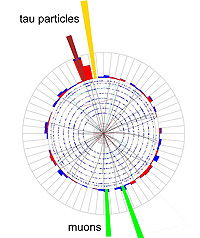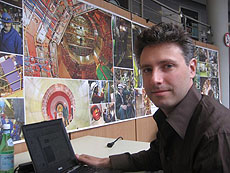The God Particle (or is it particles?)
 |
| A simulated event where h decays into aa, which in turn decays into muon and tau lepton pairs. |
Fermilab's director emeritus, Leon Lederman, wrote a book called The God Particle which described (among other things) the search for the Higgs boson. That book was first published in 1994 and fifteen years later the search continues. In fact, unless you've been totally oblivious to the exciting Tevatron program and the impending turn on of the LHC, you'll know that it is a topic that is hugely interesting for many of Fermilab's scientists.
It may surprise you that the question of whether there is only one Higgs boson is still very much open. This week, we present the results of a study in which DZero collaborators searched for a Higgs boson predicted by a super-symmetric extension of the Standard Model.
In general, in these extensions, there is not a single Higgs boson, but rather many, with different electrical charges and various quantum properties. While there are many models that incorporate the principle of supersymmetry, DZero scientists have explored one called NMSSM. In this model, the so-called "CP even" Higgs boson (h) can decay into two lighter "pseudo-scalar" Higgs bosons (a). Hence, the search was for h --> aa. Because the "a" could be extremely light, these particles could then decay into muons or tau leptons.
This is the first search at a hadron collider for this particular physics process. No evidence was observed that this proposed type of production actually occurs. While a successful observation would have been preferable, failure to observe is also an important result because it tells us what the answer is not. Since we never know which of our various ideas about the Higgs boson(s) is the correct one, until the Higgs boson is observed, we must leave no stone unturned.
-- Don Lincoln

The DZero forward muon team operates the part of the muon detectors nearest the beams. Members of the team currently at Fermilab are from left to right: S. Kulikov, of IHEP, Protvino; V.Lipaev, of IHEP, Protvino; V.Malyshev, of JINR, Dubna; V.Tokmenin, of JINR, Dubna; I.Vasilyev, of IHEP, Protvino; A. Shchukin, of IHEP, Protvino; and Yu. Yatsunenko, of JINR/Fermilab. Other physicists not currently at Fermilab also contribute.

Andy Haas, currently a Panofsky Fellow at SLAC, is the brains behind this interesting analysis.
|